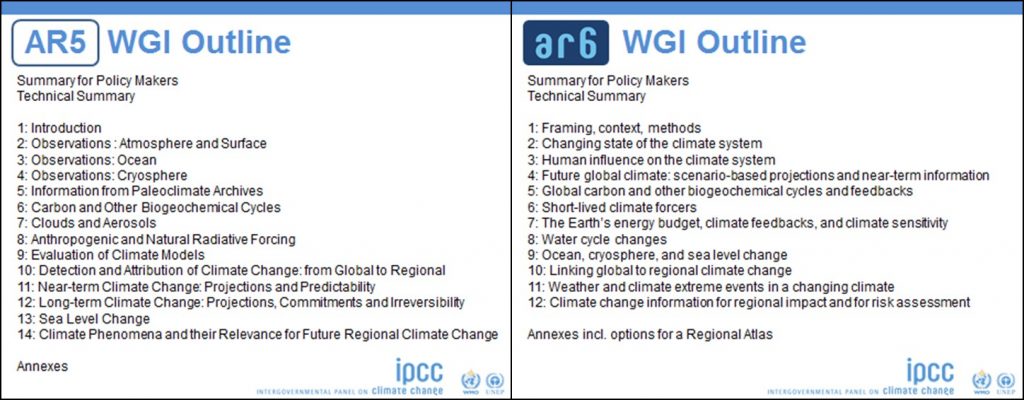
This month’s GeoPolicy post is a guest post from Sarah Connors, a Science Officer in the Intergovernmental Panel on Climate Change (IPCC) Working Group 1 Technical Support Unit (and former EGU Science Policy Officer). The IPCC is starting its sixth cycle, in which hundreds of scientists take stock of the world’s climate change knowledge by assessing the current scientific literature and then summarising this into three reports. These findings then play a vital role in supporting evidence-based climate policy around the world. The outlines, which focus on what each report will cover, were approved at a recent meeting in Montreal, Canada. This GeoPolicy post will summarise the new Working Group 1 outline and highlight how scientists can be authors in this IPCC cycle.
The process
Picture this, hundreds of delegates from countries all over the world descended on Montreal two weeks ago to discuss climate change. The gathering of all IPCC member states, known as the Plenary, occurs twice a year – this one was number 46. On the agenda was to discuss and approve the three Working Group (WG) outlines. These are lists of chapter titles and indicative bullets highlighting the topics that authors could focus on during their assessment. Almost 200 scientists drew up these proposed outlines in a meeting this summer in Addis Ababa, Ethiopia.
Each WG took it in turn to present their draft outlines to the Plenary. Country delegates then had the opportunity to ask for clarification and provide feedback, where needed. The WG Bureau (acclaimed scientists selected to steer this IPCC cycle) would then answer clarifying questions and note down all the suggestions from the floor. The Bureau then modified the outlines and presented them again to the Plenary, repeating the process as required until there was a consensus among all countries. With 195 countries being members of the IPCC, this made for long working sessions in Montreal, sometimes running late into the evening. But achieving consensus is a vital stage in the IPCC process. If all countries agree then it provides a strong platform for policy decisions to then be discussed.
The result was a huge success. All three WG outlines were accepted with minor changes (click to see the outlines for WG1, WG2, and WG3). We now have a new, easy-to-follow style for the next IPCC Working Group 1 report. In a nutshell, it will be more holistic and shorter, with increased focus on short-lived species, extremes, and regional information.
What’s new in the WG1 report? A focus on the physical science basis…
As a Science Officer based in the WG1 Technical Support Unit (TSU), my role, along with my other TSU colleagues, was to keep track of the suggested outline changes and make sure the Bureau didn’t miss anything. The new outline has changed considerably compared to the last cycle (AR5), I think for the better.
Firstly, AR5 had more chapters (14 compared to 12), which were structured beginning with what we know about climate change from observations (inc. paleo data), followed by climate processes (i.e., biogeochemical cycles) and then finishing with climate modelling (i.e., model evaluation and projections). One reason being that the scientific community’s research is structured around these themes. The next assessment (AR6) outline however, is better suited to the report’s end-users, who usually prefer having everything about a given topic all in one place. Therefore, the AR6 report will be more holistic. For example, Chapter 3 (Human influence on the climate system) will assess observational, process, and modelling literature, whereas in AR5 this literature would have been spread across multiple chapters.
Secondly, the new report will be shorter. Since the first IPCC assessment, the WG1 report has dramatically increased in length. If this continues, projections show that the AR6 report would be almost 2000 pages long and would weigh just under 5kg! Rather than repeating the work of previous assessments, the new report will provide more of an update since the AR5, thus reducing its length.
Additionally, there will be greater focus on short-lived climate forcers (Chapter 6) and extreme events (Chapter 11) than in AR5. This may include assessing literature on how climate change and air quality are interconnected in Chapter 6 and the detection and attribution of single extreme events in Chapter 11.
Finally, there is a greater regional focus in the report’s final three chapters. Much of the information developed here will support further assessment in the WG2 report, which focuses on regional climate change impacts.

Happy members of the WG1 Bureau and Technical Support Unit after approval of the WG1 report outline. Photo credit: IISD/ENB | Mike Muzurakis
Getting involved in the next steps
With the outline agreed, the IPCC is now looking for authors to compile the report. Scientists are selected based on their expertise, publication record, and coordination skills. Regional diversity, gender and previous IPCC experience are all taken into account in the selection of authors to ensure broad representation. Roughly two-thirds of the authors are new to the IPCC each cycle. Once nominations close (27 October), the authors will be selected and will get to work drafting the report. The whole process takes about four years, with the report planned for release in Spring 2021.
The IPCC actively encourages early career scientists (ECS) to participate in AR6, either as an author, an expert reviewer, or through publishing timely papers. Watch the video below for more information of ECS participation in AR6 or email the WG1 Technical Support Unit with any questions.
For more information please watch the YESS community youtube video on How can you get involved in the IPCC as an Early Career Scientist.
By Sarah Connors, Science Officer in the Intergovernmental Panel on Climate Change (IPCC)
Further reading:
The IPCC and the Sixth Assessment cycle
IPCC calls for nominations of authors for the Sixth Assessment Report
Guest post: What will be in the next IPCC climate change assessment




